Funny Comic Things to Do With a Come Along Tool
What are Webtoons?
Where does the format come from?
Webtoons originated in South Korea and are a form of digital storytelling for comics.
While this format was at first especially popular in Asian countries like South Korea, Taiwan, Thailand, and Japan in recent years, it has also become popular in western countries.
The format's vertical scroll and reading style, which is meant specifically for smartphones, is a very characteristic feature.
There are a number of popular series that have been adapted into books and TV series, such as Lore Olympus, Cheese in the Trap, and Lookism.
The platform
Webtoon, as a service is a website, where artists can upload and read comics in the described format.
To read the comics on a smartphone, it is often necessary to download the website's app.
Most Webtoons can also be read using a smartphone browser, but often it is necessary to use the app to read paid or exclusive content.
Below are some of the most notable Webtoon services.
Webtoon.com
Tapas.io
lezhin.com
Toomics
On these websites, comics by professional comic/webtoon artists are published on a regular basis and depending on the target language of the site, they are translated, for example, into English.
Additionally, on sites like Webtoon.com, comico and Tapas.io, individual artists are also able to upload their own stories for others to read.
Webtoon.com: Webtoon Canvas
Tapas.io: Publishing
Features of a Webtoon-style comic
Let's have a look at what makes the Webtoon-format different from other comics.
Reading the story vertically
The biggest difference between the Webtoon-style and conventional comics is the panel division, due to the vertical format.
Since smartphones have limited screen sizes, overlapping panels may be hard to read and often times, zooming in and out of a page is necessary to see details.
In a Webtoon-style comic, panels are arranged in a mostly vertical order, with more space in between them, to accommodate for the smaller display size. Scrolling also makes reading them easier.
For this reason, the file size is usually very long.
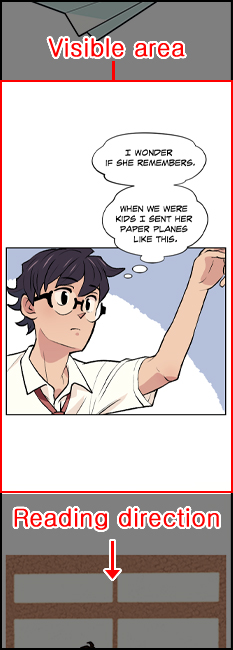
This vertical scrolling format for the panels has the following features.
1. The placement of characters and dialog is deliberately spaced.
In traditional comics and manga, the shape of the panels and the placement of characters and dialog are arranged according to the page size. Webtoon-style comics, on the other hand, make use of the long page format and arrange these elements with more space in between.
For example, if you continue to display dialog for a while, followed by the depiction of a character, you can make them seem thoughtful.
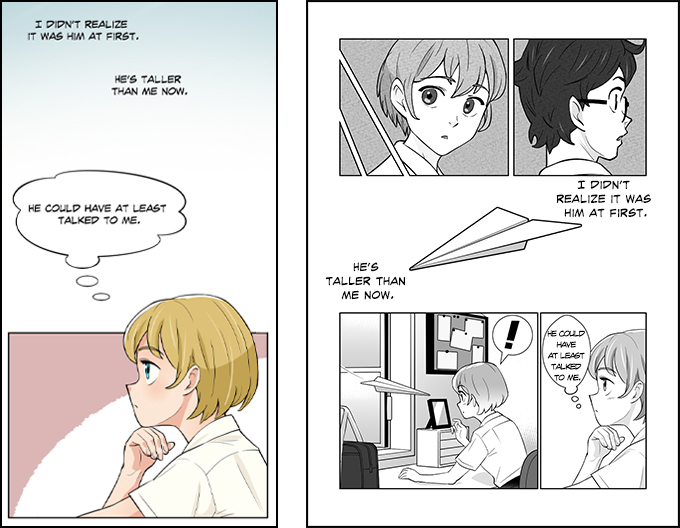
2. The space between panels is used for dramatic effect.
You can adjust the space in between panels freely and leave a lot of room, if you wish.
Depending on the size of the space between panels, the perception of the action changes. Large spaces can also be used to indicate scene changes as a whole.
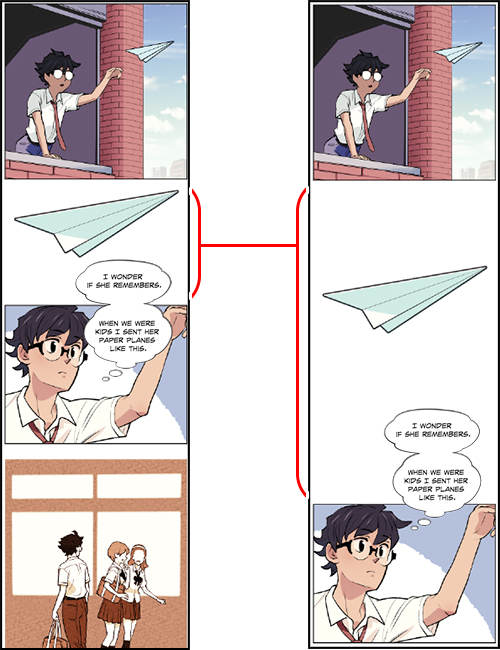
Composition and style
As the Webtoon-format is based on scrolling, there are no page turns. This means that reading itself continues uninterrupted.
In order to not break the reading flow, it is helpful to reduce the text and use a simpler art style than in traditional comics.
Color
To accommodate for smartphone screens, Webtoon-style comics are usually in color.
The area surrounding a panel is not limited to white. Black or a theme-based color is also quite common.

While in manga, screen tones and black areas are used to dramatize scenes and express time, Webtoons can make use of color for these aspects.
For example, flashbacks cannot only be indicated with solid blacks or specific frame divisions, but instead can be expressed with sepia tones.
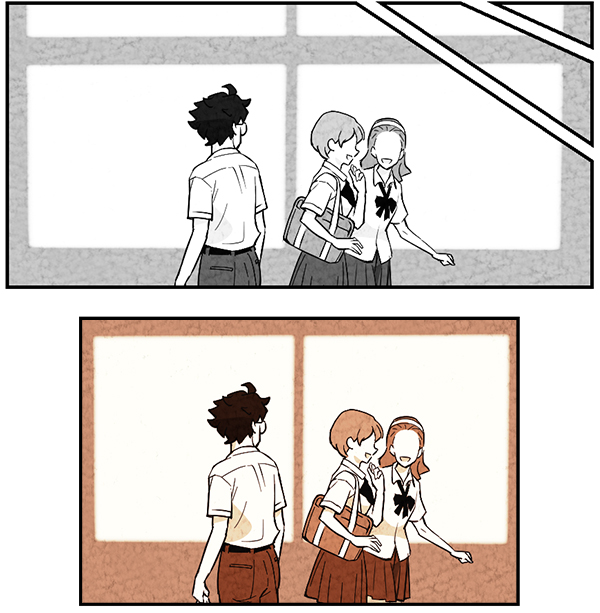
Drawing a Webtoon-style comic
Even if you would like to draw a comic in this style, you may find it difficult to express the action in a vertical format and in color. However, if you have experience drawing, you will find that there is a lot of freedom when it comes to expressions, especially when compared to the usual manga or comic format.
If you are used to drawing illustrations, this might be a great challenge for you!
Below you will find a number of tips and tricks when drawing a Webtoon-style comic in Clip Studio Paint .
Creating a vertical document
The recommended size for a vertical manuscript varies depending on the website you plan to upload your comic.
- The width is usually based on a size that fits the general screen resolution of smartphones.
- The height of a document usually only depends on the limitations of the website.
Example:
Width: 690px
Height: 7000px
Note: Based on the size specified by comico.jp.
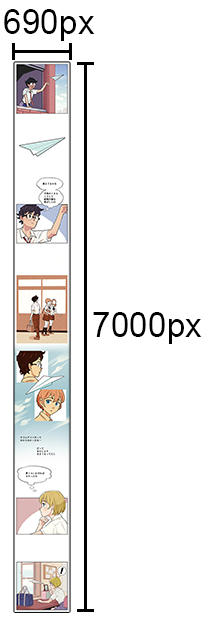
In Clip Studio Paint, you can find settings for Webtoon-style comics in the presets.
In the [New] dialog box, select [Webtoon] from [Use of work] to show settings for creating a webtoon canvas.
Select the most suitable canvas from [Preset] for the site you will post to.
The size of the canvas will vary depending on the site. If you don't find the right setting in [Preset], you can freely set the canvas from [Width] and [Height] below.
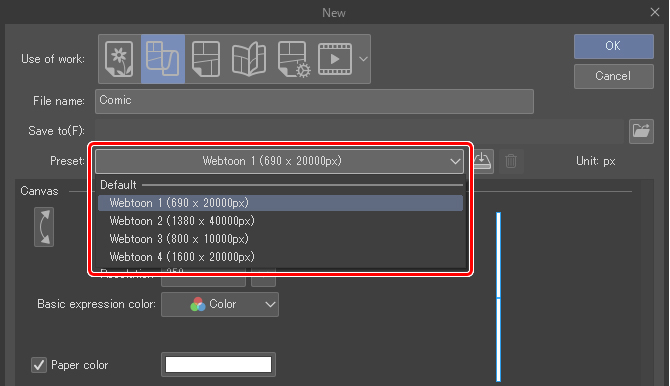
Checking the viewable area for smartphones
For vertical scrolling comics such as webtoons, adjusting the spacing of images and dialogue to fit the visible on-screen area of a smartphone can help readers read your work more effectively.
Clip Studio Paint has a [On-screen area (webtoon)] function that allows you to preview and check how the image will look on a smartphone.
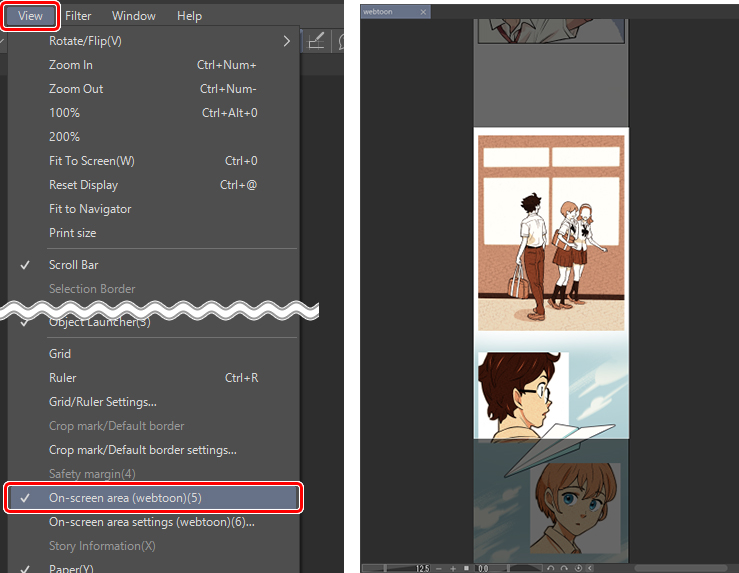
Turn on [View] menu > [On-screen area (webtoon)] to check how any part of a canvas looks on a smartphone screen.
Use it for every stage of your work from sketch to finishing details.
Splitting and exporting your work
While files on Webtoon are displayed in the long, vertical scrolling format, each file for upload is limited to a maximum height of 1280px. The uploaded files are then displayed one after the other.
However, creating a longer, vertical canvas enables you to check the overall composition and flow of the story. Cutting the canvas into the appropriate size for the upload afterwards helps you to keep an overview of the story.
Clip Studio Paint allows you to export your work into sections with a specified length.
These settings can be changed from [File] menu > [Export webtoon].
Cut the original long canvas into smaller images that are at most 1280px in height and save each file separately.
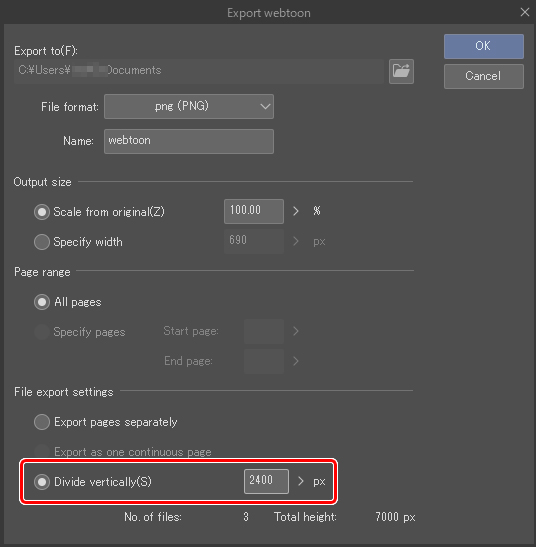

Using multiple windows to display the canvas
With such a long canvas, it is difficult to check the entire canvas when zoomed in for drawing.
If you use multiple windows in Clip Studio Paint to display the same file, you can view the canvas as a whole while also working on specific parts.
▼ Open the Window menu > Canvas > New Window to create a separate view of the same document.
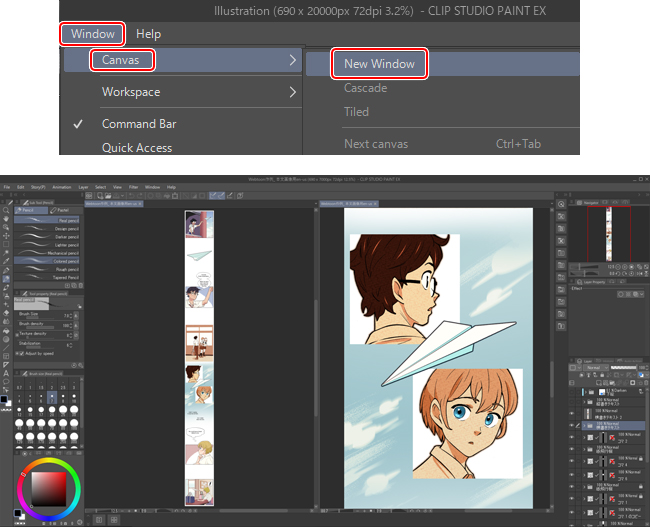
Save frequently-used colors in a Color Set
It is convenient, when drawing the same characters over and over, to create color sets for them.
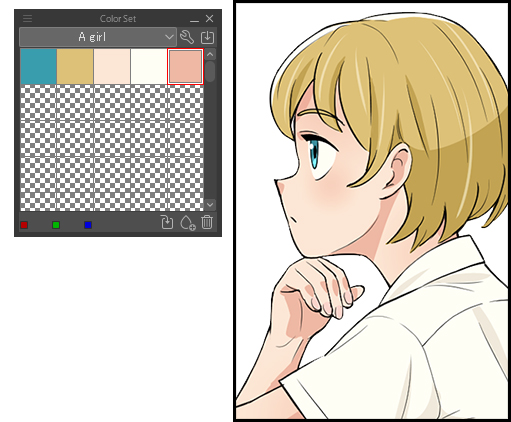
Add moods and dramatic effects with adjustment layers
Try using adjustment layers, to vary the mood in your panels.
For example, you can add a gradient map and select the sepia gradient in the dialog box. This effect is often used for flashbacks.
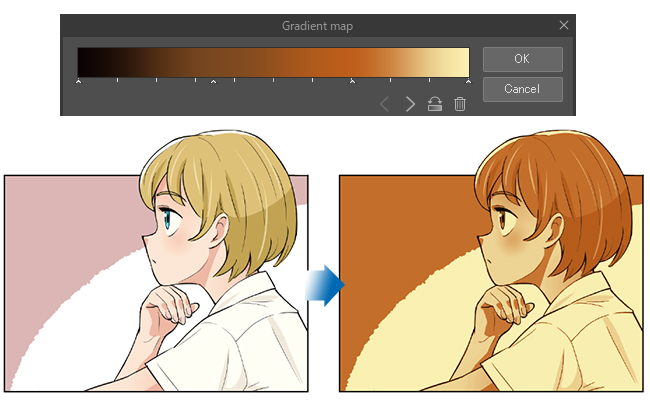
Using materials
When you use materials for backgrounds and effects, not only will you be able to change the overall expression of a scene, but you can do so more efficiently.
Clip Studio Paint offers the service Clip Studio Assets, where you can find a great variety of materials for download.
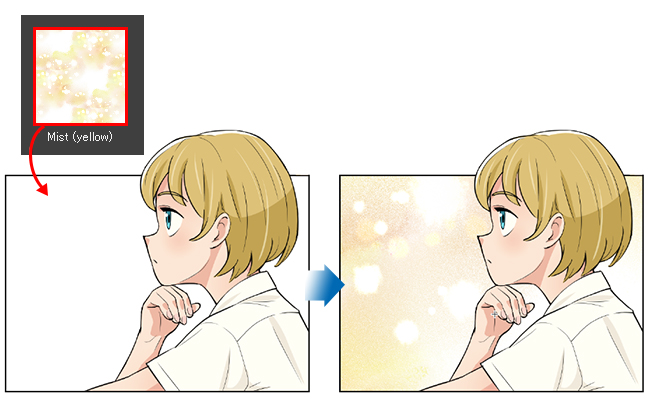
Uploading your file to a website
Once your Webtoon-style comic is finished, you can upload it just like you would with an illustration.
Creating a full comic or manga for print is a lot of work, but when it comes to Webtoon-style comics, even a shorter story with fewer panels can be uploaded and reach an audience.
In the following, we will discuss a few points to consider when uploading your comic.
Check your document type and size
Before attempting to upload your comic, make sure to check the upload guidelines for the service you wish to use.
Since changing the file type, and especially the file size, can take a lot of work, we recommend you decide on a suitable size, even before you start drawing.
– WEBTOON
Panel size: 800px wide and 1280px long per image
File size: 2MB per image, total size up to 20MB, 72 dpi or higher is recommended
Image format: jpg
– Tapas.io
Panel size: 940px wide and 4000px long per image
File size: up to 2MB per image, up to 40 images can be uploaded per episode
Image format: jpg, png, gif
Getting your comic in front of an audience
When creating a comic and putting a lot of work into it, you probably want a lot of people to read it.
Popular and new comics will usually be displayed at the top of the site you uploaded it to.
To have more people pay attention to your work, try following the steps below.
- Upload regularly
- Use inviting titles, tags and feature images
- Listen to feedback from your readers
Final checklist
・Can you upload from a smartphone?
Many platforms may only allow uploads from a desktop computer or an iPad.
If you only have a smartphone, make sure to check the website's permitted devices.
・Are you allowed to upload on multiple platforms?
・What are the content regulations?
In many cases, expressions contrary to public order and morals, as well as for-profit purposes are prohibited. Including private information or making defamatory claims of any sort within a story is usually forbidden.
Extreme depictions of violence or other mature content may be restricted. Make sure to choose your platform based on the content you wish to publish.
Source: https://www.clipstudio.net/how-to-draw/archives/157055
0 Response to "Funny Comic Things to Do With a Come Along Tool"
Post a Comment